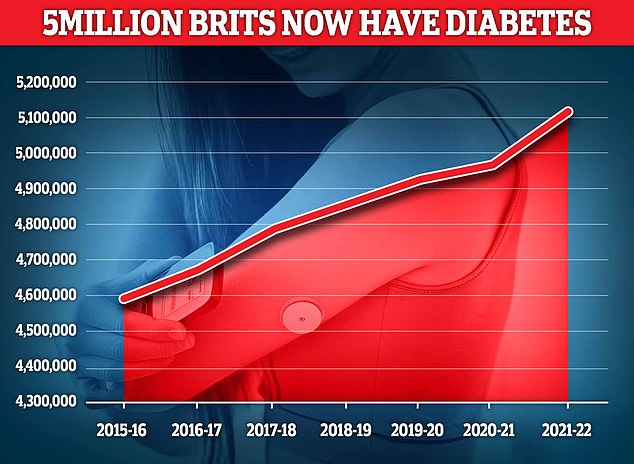Common additives hiding in thousands of ultra-processed foods (UPF) may increase the risk of type 2 diabetes, research suggests.
Emulsifiers, a group of ‘E numbers’, are used to preserve and give texture to cakes, ice creams, mayonnaise and even bread.
French scientists analyzed the diets of more than 100,000 adults to uncover the latest health fear.
The study found that adults who consumed a lot of emulsifiers were up to 15 percent more likely to have type 2 diabetes.
Critics, however, trashed the academic paper, arguing that it was just an observation and had many flaws.
Emulsifiers, a group of ‘E numbers’, are used to preserve and give texture to cakes, ice creams, mayonnaise and even bread. French scientists analyzed the diets of more than 100,000 adults to uncover the latest health fear.

Almost 4.3 million people were living with diabetes in 2021/22, according to the latest UK figures. And another 850,000 people have diabetes and are completely unaware of it, which is worrying because untreated type 2 diabetes can lead to complications such as heart disease and stroke.
Dozens of other factors could have influenced the findings, published in a journal owned by The Lancet.
Co-authors Dr Mathilde Touvier, research director at the French National Institute of Health and Medical Research, and Dr Bernard Srour, an epidemiologist at the INRAE research institute, said: “These findings… cannot be used alone to establish a causal relationship.” relationship.
“However, our results represent key elements to enrich the debate on the re-evaluation of regulations on the use of additives in the food industry, in order to better protect consumers.”
Additive-laden foods have long been vilified for their alleged risks, with some experts even calling for UPF (typically any edible food that has more artificial ingredients than natural) to be removed from diets.
The 104,000 French adults who participated in the study were asked about their eating habits (including average daily intake of different groups of emulsifiers), their personal medical history, and their level of physical activity.
During a follow-up of seven years on average, 1,056 volunteers were diagnosed with type 2 diabetes.
After taking into account other risk factors such as obesity and smoking, the researchers said that seven groups of emulsifiers were linked to type 2 diabetes.
Every 500 mg daily of tripotassium phosphate (E340), found in sliced ham, canned soups and cake mixes, was linked to a 15 percent increased risk.
Elevated probabilities were also observed with guar gum (E412) and xanthan gum (E415). They can be found in cottage cheese, salad dressings and sauces.
writing in The Lancet Diabetes and Endocrinology The researchers said the study raises “concerns.” on the need to review acceptable daily intakes for various food additives, including emulsifiers.
But today experts criticized the article.
Dr Sarah Berry, a nutritional sciences expert at King’s College London, said: “This type of large-scale epidemiological study is a vital part of the scientific process.
‘However, these studies cannot prove that emulsifiers cause type 2 diabetes.
“Because products containing emulsifiers often contain a multitude of other ingredients, unraveling the effects of each compound is challenging.”
He added: “Although the safety of emulsifiers is carefully monitored individually, few studies investigate how cocktails of these chemicals affect our health.” Therefore, this type of study should serve as a basis for future more controlled clinical trials.’
Dr Duane Mellor, a dietician at Aston University, said: “What this article does not fully consider is the difference in how the human body might process and manage emulsifiers.”
The study also considers a diverse range of emulsifiers, including baking soda, for example, he added.
“This is one of its uses, but it is perhaps more commonly used as a raising agent in the form of baking powder,” he said.
“Therefore, there appears to be some overlap between how ingredients can be classified, as they may have different uses in cooking and commercial food manufacturing.”
Type 2 diabetes occurs when the body does not produce enough insulin or the insulin it does produce does not work properly.
This hormone is necessary to reduce blood sugar levels.
Having high blood sugar levels over time can lead to heart attacks and strokes, as well as eye, kidney, and foot problems.
Sufferers may need to review their diet, take daily medications, and have regular checkups.
Symptoms of this condition, which is diagnosed with a blood test, include excessive thirst, tiredness, and the need to urinate more frequently. But many people have no symptoms.
Almost 4.3 million people were living with diabetes in 2021/22, according to the latest UK figures.
And another 850,000 people have diabetes and are completely unaware of it.
About 90 percent of diabetes cases are type 2 diabetes, which is linked to obesity and is usually diagnosed in middle age, rather than type 1 diabetes, a genetic condition that is usually identified early in life.


